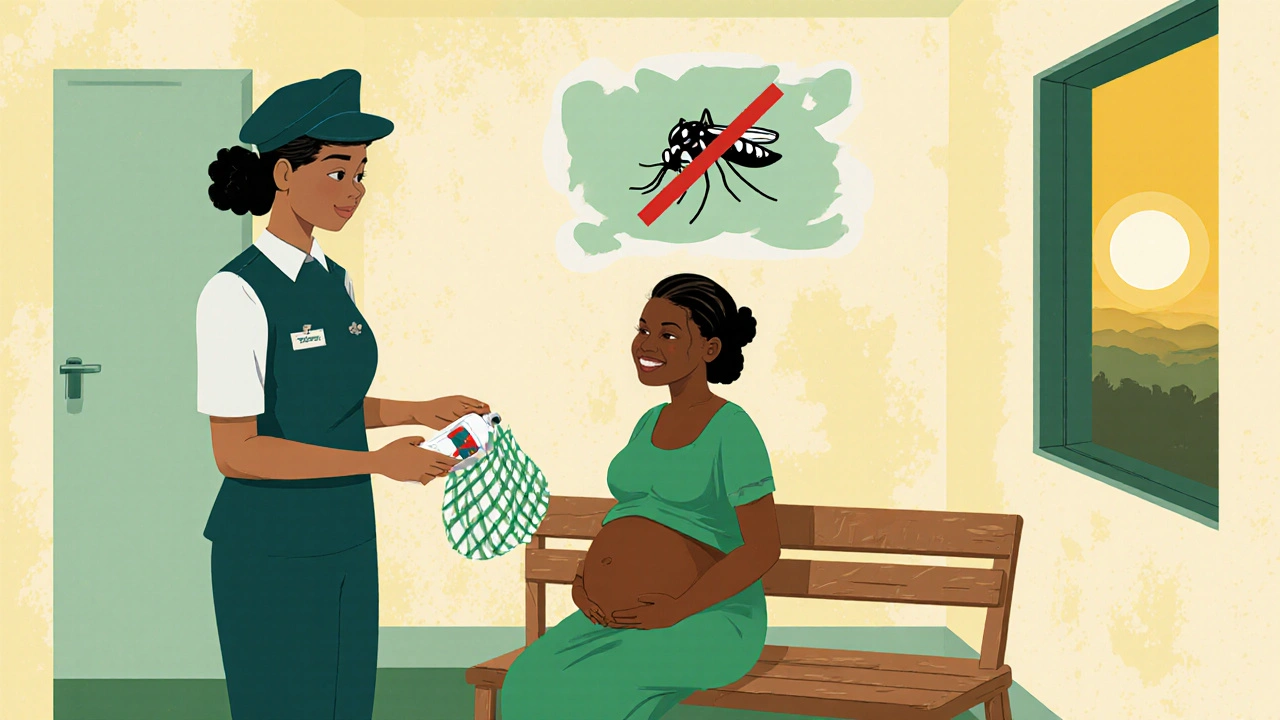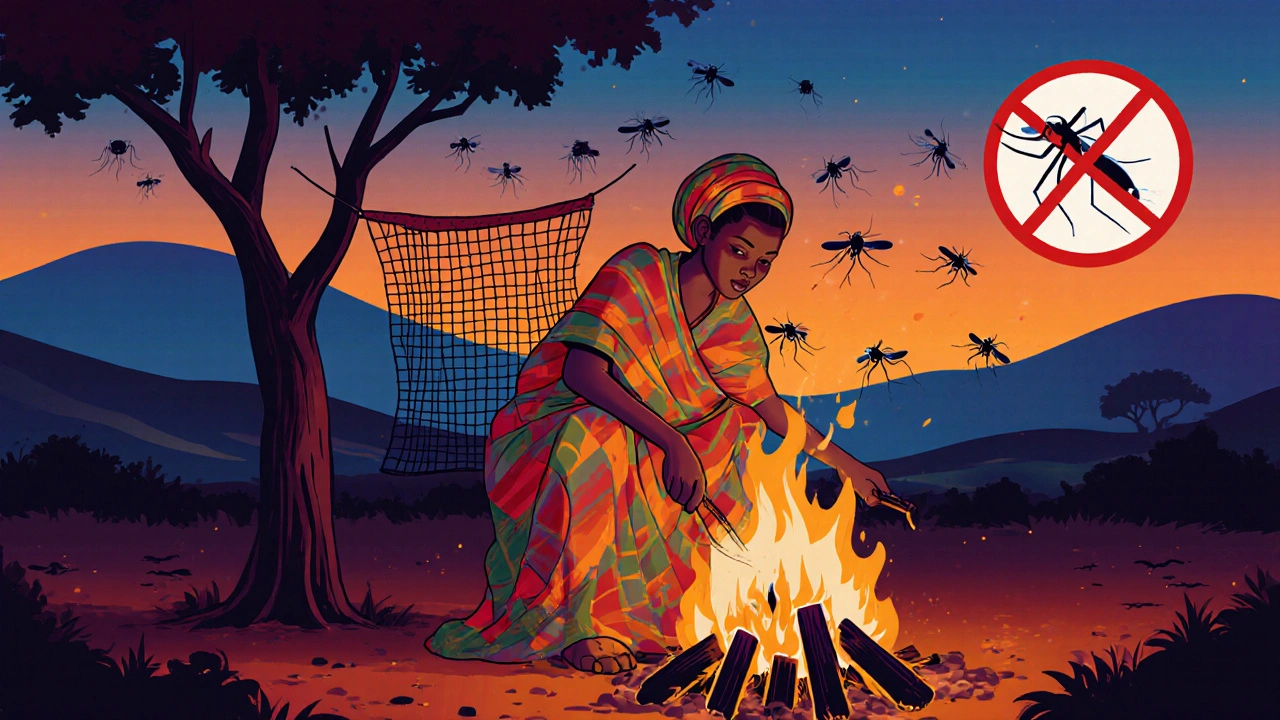Malaria Impact Calculator
How Interventions Reduce Gendered Malaria Impact
This calculator uses data from the WHO's 2023 report on malaria outcomes in Sub-Saharan Africa. Adjust intervention effectiveness to see projected impact on:
- 1 Maternal mortality among pregnant women
- 2 School absenteeism for girls
- 3 Overall malaria incidence rates
Current Malaria Outcomes (2023 Data)
With a 50% effective intervention, maternal mortality among pregnant women could decrease by 1.05 percentage points (from 2.1% to 1.05%), potentially saving 12 lives per 10,000 pregnancies.
A 40% effective school-based intervention could reduce girls' school absences by 5 days per year, potentially improving educational outcomes for 15% of affected girls.
When we talk about Malaria is a mosquito‑borne parasitic disease that causes fever, chills, and can be fatal if untreated, the gender lens often gets overlooked. Women and girls face a unique set of challenges-from pregnancy‑related complications to social barriers that limit access to prevention tools. This article breaks down why malaria hits them harder, what the data show, and how communities can close the gap.
Why Gender Matters in Malaria Risk
Gender refers to the socially constructed roles, behaviors, and expectations tied to being male or female. Those roles shape exposure to mosquito bites, health‑seeking behavior, and the resources a woman can control. In many endemic regions, women spend evenings cooking outdoors or fetching water, increasing their contact with Anopheles mosquitoes. At the same time, cultural norms may discourage them from sleeping under insecticide‑treated nets (ITNs) if men are deemed the primary protectors.
Pregnancy Amplifies the Threat
Pregnant women are especially vulnerable. The parasite can cross the placenta, leading to maternal anemia, low birth weight, and even stillbirth. According to a 2023 WHO report, malaria in pregnancy accounts for roughly 20% of all maternal deaths in Sub‑Saharan Africa. The immune system shifts during pregnancy, making it harder to clear the parasite. Additionally, ACT-the frontline treatment-has limited safety data for the first trimester, leaving clinicians with fewer options.
Girls Face Long‑Term Consequences
Beyond the immediate health impact, malaria can derail a girl’s education. Severe bouts often require weeks of bed rest, causing missed school days. A 2022 study from Kenya showed that girls who missed more than two weeks of school due to malaria were 15% less likely to complete secondary education. The ripple effect touches future earning potential and community development.
Socio‑Economic Barriers That Keep Girls at Risk
- Limited financial autonomy: In many households, women control a smaller share of income, making it harder to purchase nets or pay for treatment.
- Education gaps: Lower literacy rates among women affect awareness of malaria symptoms and preventive measures.
- Healthcare access: Rural clinics often lack diagnostic tools, and cultural norms may require a male escort for women to travel.
These factors intertwine, creating a feedback loop where malaria perpetuates gender inequality.

Health System Gaps: Where Women Slip Through the Cracks
Even when services exist, they aren’t always women‑friendly. Antenatal care visits are prime moments to distribute ITNs and provide intermittent preventive treatment (IPTp). Yet, a 2024 DHS survey found that only 57% of pregnant women in high‑transmission zones received the recommended IPTp doses. Frontline health workers often lack training on gender‑sensitive communication, reducing the likelihood that women will disclose symptoms.
Prevention Strategies Tailored to Women and Girls
- Targeted distribution of ITNs: Partner with women’s groups to deliver nets directly to households, ensuring women have control over the resource.
- Community health worker outreach: Female CHWs can visit homes, screen for fever, and educate girls about school‑based malaria programs.
- Pregnancy‑specific interventions: Strengthen IPTp delivery by integrating it with routine immunizations and offering flexible clinic hours.
- School‑based campaigns: Use after‑school clubs to teach malaria prevention, provide free net kits, and schedule periodic screening.
- Economic empowerment: Micro‑grant programs that enable women to start small businesses, freeing up income for health expenditures.
Policy and Advocacy: Making Gender a Core Pillar
Global guidelines from the WHO now call for gender‑responsive malaria programs, but adoption is uneven. Nations that have embedded gender metrics into national malaria strategic plans see faster declines in infection rates among women. Advocacy groups should push for:
- Mandatory gender impact assessments for all malaria funding proposals.
- Dedicated budget lines for women‑focused interventions.
- Data disaggregation by sex and age in all surveillance reports.
When policymakers track how many pregnant women receive IPTp or how many adolescent girls own a net, they can spot gaps before they explode into outbreaks.

Quick Comparison of Malaria Outcomes by Demographic
| Group | Incidence (per 1,000) | Case fatality rate (%) | Average days of school missed (children) |
|---|---|---|---|
| Pregnant women | 310 | 2.1 | - |
| Non‑pregnant women (15‑49) | 260 | 1.5 | - |
| Men (15‑49) | 210 | 1.2 | - |
| Girls (5‑14) | 280 | 0.9 | 12 |
| Boys (5‑14) | 250 | 0.7 | 9 |
Checklist for Community Leaders
- ✅ Ensure every antenatal visit includes a free ITN and IPTp dose.
- ✅ Train at least 50% of CHWs to be female and to use gender‑sensitive counseling scripts.
- ✅ Disaggregate surveillance data by sex and age each quarter.
- ✅ Launch a school‑based net distribution program before the rainy season.
- ✅ Allocate a portion of malaria budget to women’s economic empowerment projects.
Frequently Asked Questions
How does malaria affect pregnancy outcomes?
The parasite can cross the placenta, causing maternal anemia, low birth weight, preterm delivery, and stillbirth. In high‑transmission areas, up to one‑third of low birth weight cases are linked to malaria.
Why are adolescent girls more likely to miss school because of malaria?
Severe episodes often require weeks of bed rest. Girls also carry domestic chores that prevent quick recovery, and families may prioritize boys’ education when resources are scarce.
What preventive measures work best for pregnant women?
Intermittent preventive treatment in pregnancy (IPTp) with sulfadoxine‑pyrimethamine, combined with consistent use of insecticide‑treated nets, reduces malaria incidence by about 50%.
How can community health workers help women access treatment?
Female CHWs can conduct home visits, screen for fever, distribute rapid diagnostic tests, and escort women to clinics, overcoming cultural mobility restrictions.
Are there any risks using ACT during pregnancy?
ACT is considered safe after the first trimester. For the first trimester, clinicians often rely on quinine plus clindamycin, although research is ongoing to expand safe treatment options.
Next Steps for Readers
If you’re a health worker, start by checking your clinic’s stock of IPTp doses and nets. If you’re a community leader, organize a rapid data‑review meeting to see how many women in your area are missing preventive services. And if you’re a concerned citizen, push local officials to include gender metrics in the next malaria funding cycle. Small actions add up, and together we can close the gender gap in malaria outcomes.


Naomi Shimberg
October 23, 2025 AT 18:19While the article admirably highlights gender disparities in malaria, it overlooks the broader sociopolitical context that fundamentally shapes these outcomes. The assertion that targeted net distribution alone will close the gap ignores the entrenched power dynamics within households. Moreover, the data cited must be scrutinized for methodological rigor, given the variability across surveys. In sum, a more nuanced analysis of structural determinants is warranted.
Heather ehlschide
November 4, 2025 AT 07:06One practical step is to integrate malaria screening into existing antenatal care visits, which can increase IPTp uptake by up to 30 percent according to recent WHO field studies. Training female community health workers to conduct home‑based rapid diagnostic tests also improves early detection among pregnant women. Additionally, micro‑grant programs have demonstrated a measurable rise in net ownership when women control the budgeting process. These evidence‑based interventions complement the broader strategies outlined in the article.
Kajal Gupta
November 15, 2025 AT 20:52Hey folks, let’s sprinkle some bright ideas on this-imagine community kitchens where the firelight doubles as a mosquito‑repellent zone, turning a routine chore into a protective habit. Pair that with quirky net‑hanging contests in villages, and you get both fun and safety wrapped in one colorful package. When women lead these creative drives, the ripple effect can turn even the driest desert of resources into a blooming garden of health. So, let’s keep the conversation lively and collaborative!
Zachary Blackwell
November 27, 2025 AT 10:39Sure, but you’ll never hear the truth about pharma’s hidden hand in malaria research.
prithi mallick
December 9, 2025 AT 00:26I totally get the vibe here – the ideas are sooo inspirng and I feel the need to say keep going even if some things feel a bit too crazy sometimes htey are actually doable and i believe in the power of women leading change, even when resources seem scarce we can learn from each other and grow together, don’t let doubts stop you, you’re doing great!
Michaela Dixon
December 20, 2025 AT 14:12Malaria prevention among women requires more than just nets and drugs. It demands an understanding of daily routines that expose them to bites. Evening cooking outdoors creates a perfect environment for mosquitoes. Access to clean water reduces the need to fetch it at dusk. Education empowers girls to recognize early symptoms. Financial independence lets families buy protective gear. Community health workers can bridge gaps in remote areas. The government must allocate consistent funding for maternal health kits. Cultural norms should evolve to support women sleeping under nets. Schools can serve as distribution points for educational materials. Data collection must be sex‑disaggregated for accurate monitoring. Partnerships with local NGOs amplify outreach efforts. Research into safe medication for the first trimester remains crucial. Public‑private collaborations can innovate affordable diagnostic tools. Ultimately, sustained commitment from all stakeholders will bring lasting change.